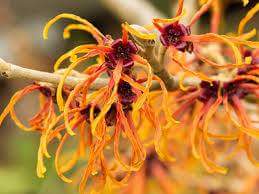What better way to celebrate the sporadic temperature shifts and “what’s next weather” of St. Louis, than enjoying the tiny but lovely first flowers of the season at the National Museum of Transportation’s Pollinator Junction. These beauties are on our Ozark Witch Hazel (Hamamelis vernalis).
The petite strappy flower petals can be a range of colors from shades of yellow to dark purple-red. The coiled ribbons of color remain rolled tight on cold cloudy days and gently unfurl on sunny days as temperatures peak. Each extended petal “bee”comes a tiny royal carpet welcoming our earliest pollinators. There is some question as to who all that might be but it obvious that these flowers are naturally intended for some tiny hungry creature as they are sweetly fragrant! No doubt some warm sunny day flower flies are hungry-and maybe honey bees (Apis mellifera).
Witch hazel is a sweet prequel to the season. Blooming from as early as January into March and sometimes is still carrying on ’til April. This unseemly long flowering period is a natural bloom period for our Missouri native Ozark witch hazel shrub. This is hardly a trick but rather a great treat to jump start the spring season.
Selecting between a cultivar (a selection that has been discovered and propagated to retain consistency of attributes) or the straight species (found and collected) was the only “which” part. There is some awareness of this shrub’s natural durability and deer resistance so growers and nurseries are helping her find her way to the home landscape.
For our purposes, ensuring the plant is attractive to pollinators is the top priority. Variation in color, elevated bloom count on an individual shrub and significant fragrance are all desirable traits that may attract and feed more pollinators. These traits vary sometimes significantly between individuals plants and yet are still within a normal range of variation. Who wants a shrub that barely blooms? We made sure to locate her in the landscape where her sweet fragrance can be appreciated!
My decision for which witch was also based on cost and to some extent maturity (size) because the larger the shrub the more branches hence more possibility for flowers and leaves. This is also a larva host plant for our small blue butterfly the Spring Azure, a very early pollinator. Her babies are tiny caterpillars that have the munchies for the foliage. We have a pollinator food producing mission!
Witch hazels live naturally in sun to part shade creating a lovely screen and are good at erosion control. I have seen great ones along the crest of stream banks where drainage is adequate. I have only seen a few poor looking ones where the ground stays wet and swampy.
WITCH HAZEL CARE
While most varieties reach 10-20 feet high and wide at maturity, witch hazels can be kept smaller with pruning once they are finished blooming. Prune in April or early May so that the following year’s buds can develop. Suckering twigs that form around the base should be removed.







 BACK TO ALL POSTS
BACK TO ALL POSTS
